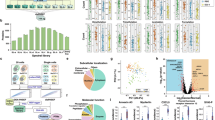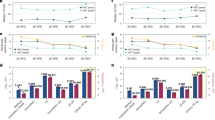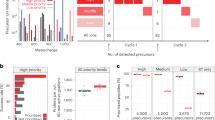Abstract
Mass spectrometry is a powerful technology for the analysis of large numbers of endogenous proteins1,2. However, the analytical challenges associated with comprehensive identification and relative quantification of cellular proteomes have so far appeared to be insurmountable3. Here, using advances in computational proteomics, instrument performance and sample preparation strategies, we compare protein levels of essentially all endogenous proteins in haploid yeast cells to their diploid counterparts. Our analysis spans more than four orders of magnitude in protein abundance with no discrimination against membrane or low level regulatory proteins. Stable-isotope labelling by amino acids in cell culture (SILAC) quantification4,5 was very accurate across the proteome, as demonstrated by one-to-one ratios of most yeast proteins. Key members of the pheromone pathway were specific to haploid yeast but others were unaltered, suggesting an efficient control mechanism of the mating response. Several retrotransposon-associated proteins were specific to haploid yeast. Gene ontology analysis pinpointed a significant change for cell wall components in agreement with geometrical considerations: diploid cells have twice the volume but not twice the surface area of haploid cells. Transcriptome levels agreed poorly with proteome changes overall. However, after filtering out low confidence microarray measurements, messenger RNA changes and SILAC ratios correlated very well for pheromone pathway components. Systems-wide, precise quantification directly at the protein level opens up new perspectives in post-genomics and systems biology.
This is a preview of subscription content, access via your institution
Access options
Subscribe to this journal
Receive 51 print issues and online access
$199.00 per year
only $3.90 per issue
Buy this article
- Purchase on SpringerLink
- Instant access to full article PDF
Prices may be subject to local taxes which are calculated during checkout




Similar content being viewed by others
References
Aebersold, R. & Mann, M. Mass spectrometry-based proteomics. Nature 422, 198–207 (2003)
Cravatt, B. F., Simon, G. M. & Yates, J. R. The biological impact of mass-spectrometry-based proteomics. Nature 450, 991–1000 (2007)
Malmstrom, J., Lee, H. & Aebersold, R. Advances in proteomic workflows for systems biology. Curr. Opin. Biotechnol. 18, 378–384 (2007)
Ong, S. E. et al. Stable isotope labeling by amino acids in cell culture, SILAC, as a simple and accurate approach to expression proteomics Mol . Cell. Proteomics 1, 376–386 (2002)
Mann, M. Functional and quantitative proteomics using SILAC. Nature Rev. Mol. Cell Biol. 7, 952–958 (2006)
Goffeau, A. et al. Life with 6000 genes. Science 274, 563–567 (1996)
Shevchenko, A. et al. Linking genome and proteome by mass spectrometry: large-scale identification of yeast proteins from two dimensional gels. Proc. Natl Acad. Sci. USA 93, 14440–14445 (1996)
Figeys, D. et al. Protein identification by solid phase microextraction-capillary zone electrophoresis-microelectrospray-tandem mass spectrometry. Nature Biotechnol. 14, 1579–1583 (1996)
Washburn, M. P., Wolters, D. & Yates, J. R. Large-scale analysis of the yeast proteome by multidimensional protein identification technology. Nature Biotechnol. 19, 242–247 (2001)
Peng, J. et al. Evaluation of multidimensional chromatography coupled with tandem mass spectrometry (LC/LC–MS/MS) for large-scale protein analysis: the yeast proteome. J. Proteome Res. 2, 43–50 (2003)
King, N. L. et al. Analysis of the Saccharomyces cerevisiae proteome with PeptideAtlas. Genome Biol. 7, R106 (2006)
de Godoy, L. M. et al. Status of complete proteome analysis by mass spectrometry: SILAC labeled yeast as a model system. Genome Biol. 7, R50 (2006)
Gruhler, A. et al. Quantitative phosphoproteomics applied to the yeast pheromone signaling pathway. Mol. Cell. Proteomics 4, 310–327 (2005)
Ghaemmaghami, S. et al. Global analysis of protein expression in yeast. Nature 425, 737–741 (2003)
Huh, W. K. et al. Global analysis of protein localization in budding yeast. Nature 425, 686–691 (2003)
Dohlman, H. G. & Slessareva, J. E. Pheromone signaling pathways in yeast. Sci. STKE 2006, cm6 (2006)
Schwartz, M. A. & Madhani, H. D. Principles of MAP kinase signaling specificity in Saccharomyces cerevisiae . Annu. Rev. Genet. 38, 725–748 (2004)
Blanc, V. M. & Adams, J. Evolution in Saccharomyces cerevisiae: identification of mutations increasing fitness in laboratory populations. Genetics 165, 975–983 (2003)
Company, M., Errede, B. & Ty, A. 1 cell-type-specific regulatory sequence is a recognition element for a constitutive binding factor. Mol. Cell. Biol. 8, 5299–5309 (1988)
Ke, N., Irwin, P. A. & Voytas, D. F. The pheromone response pathway activates transcription of Ty5 retrotransposons located within silent chromatin of Saccharomyces cerevisiae . EMBO J. 16, 6272–6280 (1997)
Tyers, M. & Mann, M. From genomics to proteomics. Nature 422, 193–197 (2003)
Galitski, T. et al. Ploidy regulation of gene expression. Science 285, 251–254 (1999)
Cox, J. & Mann, M. Is proteomics the new genomics? Cell 130, 395–398 (2007)
Olsen, J. V. et al. Parts per million mass accuracy on an orbitrap mass spectrometer via lock mass injection into a C-trap. Mol. Cell. Proteomics 4, 2010–2021 (2005)
Perkins, D. N. et al. Probability-based protein identification by searching sequence databases using mass spectrometry data. Electrophoresis 20, 3551–3567 (1999)
Rappsilber, J., Ishihama, Y. & Mann, M. Stop and go extraction tips for matrix-assisted laser desorption/ionization, nanoelectrospray, and LC/MS sample pretreatment in proteomics. Anal. Chem. 75, 663–670 (2003)
Shevchenko, A. et al. Mass spectrometric sequencing of proteins silver-stained polyacrylamide gels. Anal. Chem. 68, 850–858 (1996)
Mann, M. & Wilm, M. Error-tolerant identification of peptides in sequence databases by peptide sequence tags. Anal. Chem. 66, 4390–4399 (1994)
Acknowledgements
G. de Souza measured part of the yeast proteome; C. Kumar contributed to bioinformatic analysis, G. Stoehr to proteome analysis. Z. Storchova provided the pGAL-HO plasmid. L.M.F.d.G. thanks D. Bertozzi for support and discussions. The Max-Planck Society and the DC-Thera and Interaction Proteome 6th framework projects of the European Union provided funding; T.C.W. is supported by the Human Frontier Science Program and M.L.N. by the European Molecular Biology Organization (EMBO).
Author information
Authors and Affiliations
Corresponding authors
Supplementary information
Supplementary Information
This file contains Supplementary Materials, Supplementary References, Supplementary Figures 1-10 with Legends, Supplementary Tables 5, 9, 10, and a description of columns in Excel sheets for proteome identification and quantitation for Supplementary Tables 1,2,3,4, and 6 (protein lists), Supplementary Table 7 (peptides list) and Supplementary Table 8 (KEGG and GO analysis). (PDF 11070 kb)
Supplementary Table 1
Supplementary Table 1: List of identified proteins for strategy a (trypsin experiment). (XLS 4904 kb)
Supplementary Table 2
Supplementary Table 2: List of identified proteins for strategy b (IEF-Full mass range MS - Lys-C experiment). (XLS 5339 kb)
Supplementary Table 3
Supplementary Table 3: List of identified proteins for strategy c (IEF-Narrow MS ranges - Lys-C experiments). (XLS 5048 kb)
Supplementary Table 4
Supplementary Table 4: List of identified proteins for strategies abc (trypsin and Lys-C experiment). (XLS 5924 kb)
Supplementary Table 6
Supplementary Table 6: Quantitative data for Lys-C experiment (proteins). (XLS 5435 kb)
Supplementary Table 7
Supplementary Table 7: Quantitative data for Lys-C experiment (peptides). (XLS 12183 kb)
Supplementary Table 8
Supplementary Table 8: Gene Ontology and Kegg pathway analysis of protein classes. (XLS 39 kb)
Supplementary Table 11
Supplementary Table 11: Gene Ontology and Kegg pathway analysis of protein classes. (XLS 35 kb)
Rights and permissions
About this article
Cite this article
de Godoy, L., Olsen, J., Cox, J. et al. Comprehensive mass-spectrometry-based proteome quantification of haploid versus diploid yeast. Nature 455, 1251–1254 (2008). https://doi.org/10.1038/nature07341
Received:
Accepted:
Published:
Issue Date:
DOI: https://doi.org/10.1038/nature07341



